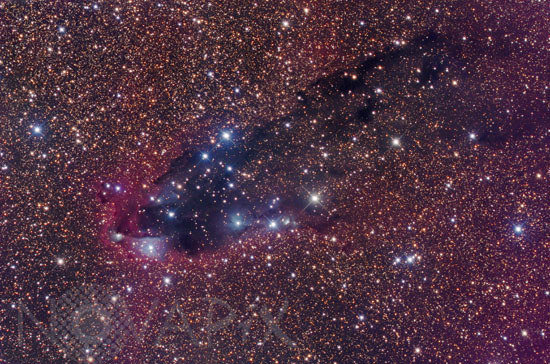Photo Agency - Astronomy - Space - Nature

A dark cloud in Scorpius
author: R.Gendler/Novapix
reference: a-neb98-00112
Image Size 300 DPI: 33 * 22 cm
Unnamed nebula in Scorpius.
Bright rimmed globules and their more evolved cousin the cometary globule represent fascinating dynamic structures formed by the interplay of cold molecular clouds and hot ionizing stars. Typically the head of the globule faces a hot O-type star. Intense radiation from the star boils away lower density gas from the head. The evaporated rim of gas becomes ionized by the stars ultraviolet flux forming a bright glowing rim we associate with many of these globules including CG4. Intense stellar winds from the ionizing star evaporate gas and dust away from the head forming the "tail" and completing the cometary shape. The globules are known to be the birthplace of low mass stars. Stars form within the globules by the mechanism known as "radiation driven implosion". This process occurs when ultraviolet flux from a hot star compresses surviving clumps of cold molecular gas eventually causing collapse and core formation within the dense compact clouds. Lower and intermediate mass stars ultimately form from the compact gas and dust within the globules.
Bright rimmed globules and their more evolved cousin the cometary globule represent fascinating dynamic structures formed by the interplay of cold molecular clouds and hot ionizing stars. Typically the head of the globule faces a hot O-type star. Intense radiation from the star boils away lower density gas from the head. The evaporated rim of gas becomes ionized by the stars ultraviolet flux forming a bright glowing rim we associate with many of these globules including CG4. Intense stellar winds from the ionizing star evaporate gas and dust away from the head forming the "tail" and completing the cometary shape. The globules are known to be the birthplace of low mass stars. Stars form within the globules by the mechanism known as "radiation driven implosion". This process occurs when ultraviolet flux from a hot star compresses surviving clumps of cold molecular gas eventually causing collapse and core formation within the dense compact clouds. Lower and intermediate mass stars ultimately form from the compact gas and dust within the globules.
Keywords for this photo:
2008 - ASTRONOMY - COMETARY GLOBULE - DARK NEBULA - NEBULA - SCORPIUS - STAR - STAR FORMATION -
Contact : Stéphane Aubin +33-(0)9-51-26-53-76
© Novapix - All rights reserved


